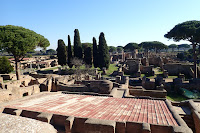This morning it was a two-kilometer walk from Testaccio to the Baths of Caracalla. This extraordinary works was opened in the year 216 and was in operation for over three hundred years, until the aqueducts that provided its water were destroyed. The remaining buildings have withstood centuries of plundering and even some damaging earthquakes. The mosaic floor of what would have been an Olympic-size pool still exists mostly intact.
We saw many of the local feral parakeets, descendants of birds that escaped from private aviaries in the 1970s and 1980s. They've been able to adapt to urban life in Rome since the winters are mild. Their squeaks and squabbles could be heard all around the neighborhood.
This large area held an Olympic-size pool
Parts of mosaics were on display
Some lively locals
At a nearby rail station we each paid $1.50 for the 30-minute commuter train to the seaside town of Ostia. The original colony (dating to about 3rd century BC), now known as Ostia Antica, once had nearly 100,000 residents by the 3rd century AD. It was a prosperous port city on the Tiber River. Over the centuries old Ostia was sacked during times of civil war and occasionally raided by pirates. By the 9th century after the course of the Tiber had changed enough to make its port less useful the residents largely abandoned the city. The area gradually filled in with sediment. Parts above ground were used as quarries occasionally. It wasn't until about the late 1930s that excavations began in earnest. In the 1960s and 1970s the area was used as an archaeological teaching site. It's believed that about two thirds of the ancient city remains un-excavated, which is amazing because the area was much much larger than Hans or I anticipated. After four hours of exploring we still hadn't seen everything! One of the fantastic things about visiting Ostia Antica is that there are actually very few areas where you can't wander. Almost all of it was open for exploration, so we spent a lot of time time wandering through the labyrinth-like baths and old commercial district. We wandered in circles at times through some of the old cult temples. It was a truly unique experience.
The baths
The old theater
Stalls in the old market square
Some of the apartment buildings are thought to have been four stories tall
Communal latrines with running water channels
At the end of the day we went back to the hotel and started the chore of re-packing. Once the sun went down we walked across the river for our last Roman dinner at a cozy restaurant, La Tavernaccia. I asked our server for a wine recommendation, specifically from the Lazio region. He proudly presented us with a bottle of red and declared it his absolute favorite wine, even suggesting that if Hans and I didn't like it he would be happy to finish the bottle! :)
For the next several hours we tucked into a wonderful meal. My globe of buffalo mozzarella was pretty darn tasty. I wish I could remember everything else that we ate! I had their pasta alla gricia and surely some other main...I think Hans had the stuffed veal.
We went to bed pretty happy.
Testaccio sits next to a burial chamber from the year 12 BC. Egyptian architecture was all the rage in Rome back then! This is why there are so many obelisks all over town.
Dinner first course
Sunday morning. Arrivederci!



















































No comments:
Post a Comment